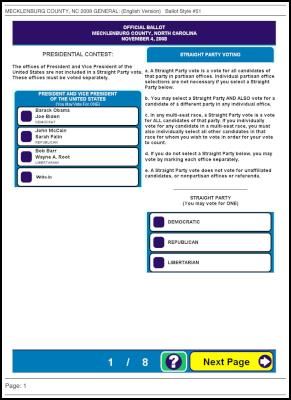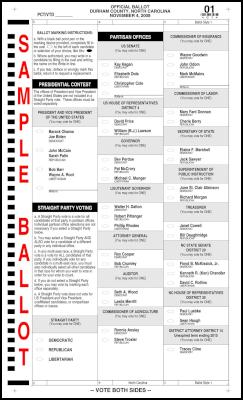How Bad Is North Carolina’s Ballot Flaw?
How Bad is North Carolina’s Ballot Flaw?
The Numbers Say, Pretty Bad
By Lawrence Norden & Margaret Chen, Brennan
Center for
Justice
10/21/08

Click to enlarge
Some of you may have read about North Carolina's very confusing straight-party voting rules and ballots. If history is any guide, this has the potential to have a huge impact on the outcome of the presidential contest in North Carolina.
North Carolina, like 14 other states, has an option on the ballot that allows voters to cast a straight-party ballot with one mark. Straight-party voting allows voters to vote quickly and easily, and often results in more votes for down-ballot contests. But it presents some serious usability challenges for voters. And In North Carolina, straight-party voting is particularly tricky: a straight-party vote (counter-intuitively) does not include a vote for president - voters must make a separate mark under the presidential contest (this is in contrast to other states, like Texas, where attempting to vote for President after choosing straight party voting could nullify one's vote).
Perhaps not surprisingly, in the last few elections, North Carolina has had an unusually high number of voters who did not cast votes in the presidential election. Dr. Justin Moore of Duke University estimates 3.15% of voters did not have votes recorded for President in 2000, and 2.57% did not have votes cast for president in 2004. As we noted in our recent report Better Ballots, having more than 1% of voters fail to cast a vote in the presidential contest is unusual and often an indication of a ballot design flaw or other problem.
It's possible that North Carolina's confusing straight-party voting law and ballots haven't attracted much attention in the past because there hasn't been a close presidential contest in the state in quite some time. But this year, having 2% or more of voters inadvertantly skip the presidential contest may very well have an impact on the outcome. As we've noted before, ballot design flaws tend to disproportionaltely impact three groups, who are likely to be heavily represented in North Carolina's election this year: the poor, the elderly, and new voters.
We've posted a couple of sample ballots from this year's election in North Carolina. One is a paper optical scan ballot being used in Durham County. And one is a "DRE" or electronic ballot being used in Mecklenburg County. North Carolina's optical scan and electronic ballots have some good features that are discussed in Better Ballots, such as shading office titles, that will help voters navigate the ballot. The straight-party voting option, however, could cause thousands of lost votes.

Click to enlarge
Although North Carolina has written detailed instructions for straight-party voting, the most important instruction - warning voters that a straight-party vote does not include a vote for President - appears last in the list. Buried in a block of text that takes up nearly third of the first column of optical scan ballots, or half of a DRE electronic ballot screen, both experienced and first-time voters are likely to miss this crucial information.
A better optical scan ballot layout would have bumped the straight-party voting information to the second column, to ensure that voters don't miss the presidential contest that is listed first. A better DRE electronic ballot layout would have placed the presidential race by itself on the first screen, followed by the straight-party voting option on the next screen, to ensure that voters are aware that these are separate voting tasks.
The Brennan Center calls on election officials to make sure that North Carolina voters are aware that a straight-party vote does not include a vote for president, and that they must make a mark in the presidential contest for a vote for president to be counted. At the same time, we're working with local voting rights groups in North Carolina to get the word out far and wide.
Update: We just spoke to Professor David Kimball, Professor of Political Science at the University of Missouri, St. Louis who notes that until as recently as 2007 (when the law was changed), the only other state that did not include the presidential contest in its straight party voting was South Carolina which - surprise - had similarly high "undervote" rates in the presidential contest in 2000 and 2004.
About the Author
Mr. Norden is the project director for the Voting Technology Project. As Counsel at the Brennan Center, Mr. Norden works in the areas of voting systems, voting rights and government accountability. In addition to these responsibilities, he edits and writes for the Brennan Center’s blog on New York State, ReformNY.
Ms. Chen joined the Brennan Center in June 2006. As Senior Research Associate in the Democracy Program, she focuses on voting rights and elections.


 Binoy Kampmark: Fallibility, Dirty Wars And Pope Francis I
Binoy Kampmark: Fallibility, Dirty Wars And Pope Francis I Peter Dunne: Dunne's Weekly - An Issue No-one Can Afford To Lose
Peter Dunne: Dunne's Weekly - An Issue No-one Can Afford To Lose Martin LeFevre - Meditations: Choosing Mass Murder?
Martin LeFevre - Meditations: Choosing Mass Murder? Eugene Doyle: Quiet Mutiny - The U.S. Army Falls Apart
Eugene Doyle: Quiet Mutiny - The U.S. Army Falls Apart Gordon Campbell: Papal Picks, And India As A Defence Ally
Gordon Campbell: Papal Picks, And India As A Defence Ally Binoy Kampmark: The Selling Of America - Ending The US Dollar’s Exorbitant Privilege
Binoy Kampmark: The Selling Of America - Ending The US Dollar’s Exorbitant Privilege